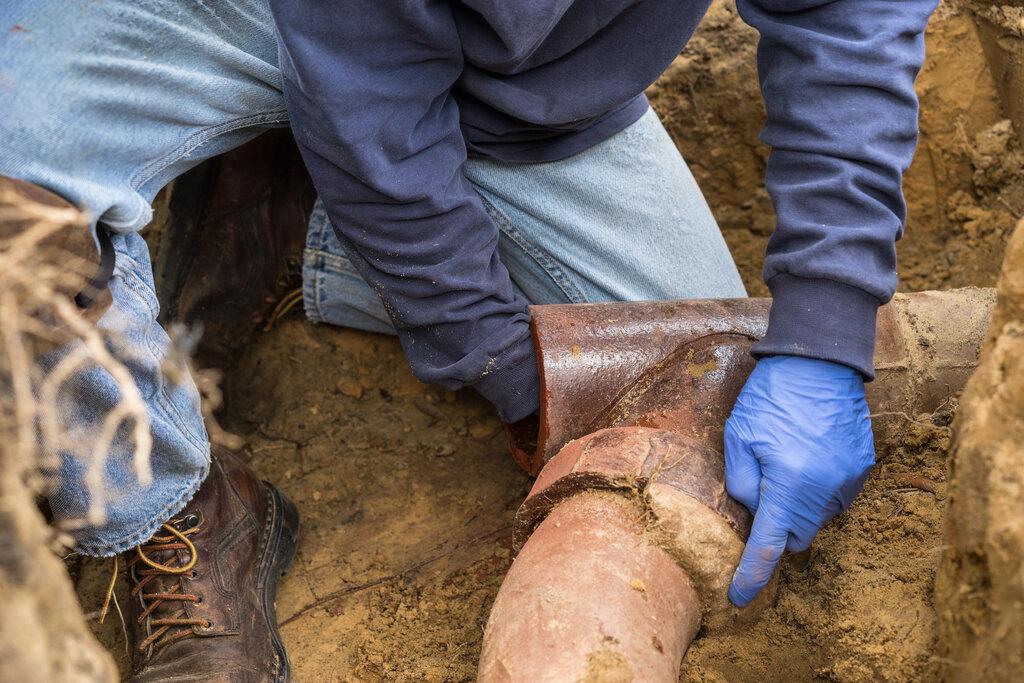
Have you or someone you know been affected by tree roots in your sewer lines? Call Benjamin Franklin NOW (not kidding!) to see if you qualify for compensation (kidding).
Believe it or not, your landscaping could be a danger to your plumbing system. Tree roots will travel long distances to find water, especially when drought conditions persist. When trees and shrubs get thirsty, they follow the trail of moisture vapors and penetrate openings to reach the nutrients and moisture inside the pipes. They first access your line by growing between pipe joints. Once they are there, they grow and expand over time, eventually collapsing the line.
Root systems are extremely powerful – they can place considerable strain on a crack or pipe joint, often breaking the pipe and resulting in a costly repair or replacement. If incoming water or outgoing sewer lines gurgle, bubble or run slowly and you suspect a clog, the problem isn’t likely to go away on its own. It’s time to call in a professional to investigate the problem.
Signs that you may have a root issue:
Drains are slow and gurgling toilets
A gurgling toilet or slow emptying drains is one of the most common signs when dealing with roots. Since roots creep into the inside walls of the pipe and block the flow of waste. Toilet paper and other solids get caught up and cause the slow draining that eventually develops into a sewage backup. Note: The risk is especially high in older homes or properties with large trees nearby!
An increase in insects & rodents around the property
Insects such as cockroaches, flies and centipedes naturally flock to nasty smelling areas and find their way into cracked sewer lines. Mice & rats can live in sewer cracks – a perfect place for a small animal to call home.
Sinkholes in the yard
If a visible sinkhole forms in your lawn, stay away from it, and immediately call a plumber to come out and inspect the issue. Your foundation may be in danger & it can eventually develop into an unsanitary ponding condition.
Unusually healthy plants or trees
Sometimes examining the lushness of your landscaping can be a way to spot a potential root problem. If you notice healthier plants and trees in a certain area of your yard this may be the cause of root intrusion in a cracked sewer pipe.
A plumber can do a camera inspection of your pipes to identify if you have any of the following problems:
Collapsed pipes
As roots grow in a sewer line, they allow wastewater to escape creating a belly caused by ground erosion that results in a collapsed pipe. Collapsed or offset pipes can be caused by shifting ground or shoddy installation but are more frequently associated with an untreated belly or significant tree root damage. Over time, either of these two circumstances compromises the structural integrity of the pipe, causing permanent damage.
Sewer Line Bellies
When an improperly fitted pipe joint or cracks from tree roots cause a pipe to leak wastewater, it erodes soil around a pipe. This erosion causes a sewer line to sag, creating a “belly”. Standing wastewater gets trapped in the belly, slowing the drain, and eventually causing a permanent blockage due to a collapsed or offset pipe.
Call your local friendly Benjamin Franklin Plumber
You can minimize the chances of root intrusion by limiting the number and types of plants near sewer lines. When planting large trees, consider locations carefully and be sure to place them where the roots can’t reach pipes.
But, if any of these situations happen to you, the only permanent fix may be to replace your sewer line. Be sure to explore your options! While most plumbers must dig up your entire yard to replace a line, trenchless sewer line replacement may be available in your area. With trenchless technology, a plumber can replace your sewer line with just a few small holes, avoiding significant damage to your yard.
Get a professional assessment of your drain lines by calling Benjamin Franklin Plumbing our team of licensed plumbing service specialists. Don't wait – reach out before the trouble worsens.
